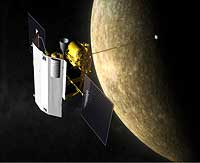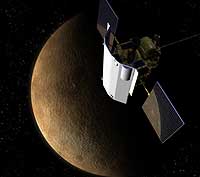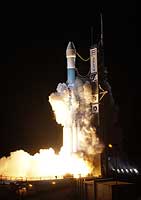
Mercury Surface, Space Environment, Geochemistry and Ranging
Courtesy of NASA's National Space Science Data Center
Table of Contents
- Description
- Mission Profile
- Spacecraft and Subsystems
- Photos of MESSENGER
- MESSENGER Project Home Page
Launch Date/Time: 2004-08-03 at 06:15:56 UTC
On-orbit dry mass: 485.2 kg
Nominal Power Output: 450 W
Description
The Mercury Surface, Space Environment, Geochemistry and Ranging (MESSENGER) mission is designed to study the characteristics and environment of Mercury from orbit. Specifically, the scientific objectives of the mission are to characterize the chemical composition of Mercury's surface, the geologic history, the nature of the magnetic field, the size and state of the core, the volatile inventory at the poles, and the nature of Mercury's exosphere and magnetosphere over a nominal orbital mission of one Earth year.
MESSENGER launched on 3 August 2004 at 6:15:56 UT (2:15:56 a.m. EDT) on a Delta 7925H (a Delta II Heavy launch vehicle with nine strap-on solid-rocket boosters). The spacecraft was injected into solar orbit 57 minutes later. The solar panels were then deployed and the spacecraft began sending data on its status. One year after launch, on 2 August 2005, MESSENGER flew by Earth at an altitude of 2347 km. On 12 December 2005 at 11:30 UT, MESSENGER fired its large thruster for 524 seconds, changing the spacecraft velocity by 316 m/s and putting it on course for its 24 October 2006 Venus flyby at an altitude of 2990 km. The second Venus flyby took place on 5 June 2007 at 23:08 UT (7:08 p.m. EDT) at an altitude of approximately 337 km. The first of three Mercury flybys, all at 200 km altitude, will be on 14 January 2008, the second will be on 6 October 2008, and the third on 29 September 2009. There will also be five deep space manuevers. Data collected during the Mercury flybys will be used to help plan the scientific campaign during the orbital phase. Mercury orbit insertion will take place on 18 March 2011, requiring a delta-V of 0.867 km/s. The nominal orbit is planned to have a periapsis of 200 km at 60 degrees N latitude, an apoapsis of 15,193 km, a period of 12 hours and an inclination of 80 degrees. The periapsis will slowly rise due to solar perturbations to over 400 km at the end of 88 days (one Mercury year) at which point it will be readjusted to a 200 km, 12 hour orbit via a two burn sequence. Data will be collected from orbit for one Earth year, the nominal end of the primary mission will be in March 2012. Global stereo image coverage at 250 m/pixel resolution is expected. The mission should also yield global composition maps, a 3-D model of Mercury's magnetosphere, topographic profiles of the northern hemisphere, gravity field to degree and order 16, altitude profiles of elemental species, and a characterization of the volatiles in permanently shadowed craters at the poles.
The MESSENGER spacecraft is a squat box (1.27 m x 1.42 m x 1.85 m) with a semi-cylindrical thermal shade (roughly 2.5 meters tall and 2 meters wide) for protection from the Sun and two solar panel wings extending radially about 6 meters from tip to tip. A 3.6 m magnetometer boom also extends from the craft. The total mass of the spacecraft is 1093 kg, 607.8 kg of this is propellant and helium. The structure is primarily graphite-cyanate-ester (GrCE) composite and consists of two vertical panels which support two large fuel tanks and two vertical panels which support the oxidizer tank and plumbing panel. The four vertical panels make up the center column and are bolted at their aft ends to an aluminum adapter. A single top deck panel mounts the LVA (large velocity adjust) thruster, small thrusters, helium and auxiliary fuel tanks, star trackers and battery.
Main propulsion is via the 645-N, 317-s bipropellant LVA thruster, four 22-N monopropellant thrusters provide spacecraft steering during main thruster burns, and ten 4-N monopropellant thrusters are used for attitude control. There is also a reaction-wheel attitude control system. Knowledge for attitude control is provided by star tracking cameras, an inertial measurement unit, and six solar sensors. Power is provided by the solar panels, which extend beyond the sunshade and are rotatable to balance panel temperature and power generation, which provides a nominal 450 W in Mercury orbit. The panels are 70% optical solar reflectors and 30% GaAs/Ge cells. The power is stored in a common-pressure-vessel nickel-hydrogen battery, with 11 vessels and 2 cells per vessel.
Communications are in X-band with downlink through two fixed phased-array antenna clusters and uplink and downlink through medium- and low-gain antennas on the forward and aft sides of the spacecraft. Passive thermal control, primarily a fixed opaque ceramic cloth sunshade, is utilized to maintain operating temperatures near the Sun. Radiators are built into the structure and the orbit is optimized to minimize infrared and visible light heating of the spacecraft from the surface of Mercury. Multilayer insulation, low conductivity couplings, and heaters are also used to maintain temperatures within operating limits.
Five science instruments are mounted externally on the bottom deck of the main body: the Mercury Dual Imaging System (MDIS), Gamma-Ray and Neutron Spectrometer (GRNS), X-ray Spectrometer (XRS), Mercury Laser Altimeter (MLA), and Atmospheric and Surface Composition Spectrometer (MASCS). The Energetic Particle and Plasma Spectrometer (EPPS) is mounted on the side and top deck and the magnetometer (MAG) is at the end of the 3.6 m boom. Radio Science (RS) experiments will use the existing communications system.
 MESSENGER Departing Earth
MESSENGER Departing Earth
Artist's impression of the MErcury Surface, Space ENvironment, GEochemistry, and Ranging (MESSENGER) spacecraft as it leaves Earth, following its Aug. 3, 2004 launch from Cape Canaveral Air Force Station, Fla. aboard a Delta II rocket. The spacecraft will fly past Earth once, Venus twice and Mercury three times before starting a yearlong orbital study of the innermost planet in March 2011.
(Courtesy NASA/JHUAPL)
 MESSENGER at Mercury
MESSENGER at Mercury
Artist's impression of the MErcury Surface, Space ENvironment, GEochemistry, and Ranging (MESSENGER) spacecraft in orbit at Mercury. MESSENGER launched from Cape Canaveral Air Force Station, Fla., on Aug. 3, 2004, and will begin a yearlong orbital study of Mercury in March 2011. Though the Sun is up to 11 times brighter at Mercury than we see on Earth and surface temperatures can reach 450 degrees Celsius (about 840 degrees Fahrenheit), MESSENGER's instruments will operate at room temperature behind a sunshade of heat-resistant ceramic fabric. The spacecraft will also pass only briefly over the hottest parts of the surface, limiting exposure to heat reradiated from the planet.
(Courtesy NASA/JHUAPL)
 MESSENGER in Orbit With Sun
MESSENGER in Orbit With Sun
Artist's impression of the MErcury Surface, Space ENvironment, GEochemistry, and Ranging (MESSENGER) spacecraft in orbit at Mercury. MESSENGER launched from Cape Canaveral Air Force Station, Fla., on Aug. 3, 2004, and will begin a yearlong orbital study of Mercury in March 2011. Though the Sun is up to 11 times brighter at Mercury than we see on Earth and surface temperatures can reach 450 degrees Celsius (about 840 degrees Fahrenheit), MESSENGER's instruments will operate at room temperature behind a sunshade of heat-resistant ceramic fabric. The spacecraft will also pass only briefly over the hottest parts of the surface, limiting exposure to heat reradiated from the planet.
(Courtesy NASA/JHUAPL)
 MESSENGER in Orbit With Planet
MESSENGER in Orbit With Planet
Artist's impression of the MErcury Surface, Space ENvironment, GEochemistry, and Ranging (MESSENGER) spacecraft in orbit at Mercury. MESSENGER launched from Cape Canaveral Air Force Station, Fla., on Aug. 3, 2004, and will begin a yearlong orbital study of Mercury in March 2011. Though the Sun is up to 11 times brighter at Mercury than we see on Earth and surface temperatures can reach 450 degrees Celsius (about 840 degrees Fahrenheit), MESSENGER's instruments will operate at room temperature behind a sunshade of heat-resistant ceramic fabric. The spacecraft will also pass only briefly over the hottest parts of the surface, limiting exposure to heat reradiated from the planet.
(Courtesy NASA/JHUAPL)
 MESSENGER Spacecraft
MESSENGER Spacecraft
KENNEDY SPACE CENTER, FLA. - The MESSENGER (Mercury Surface, Space Environment, Geochemistry and Ranging) spacecraft, mated to the Delta II third stage Payload Assist Module, is ready for presentation to the media at Astrotech Space Operations in Titusville, Fla. Spokespersons for the event are Dr. Robert Gold, MESSENGER payload manager with The Johns Hopkins University Applied Physics Laboratory (APL); and Ted Hartka, MESSENGER lead mechanical engineer, APL. MESSENGER is scheduled to launch Aug. 2 aboard a Boeing Delta II rocket from Pad 17-B, Cape Canaveral Air Force Station, Fla.
(Courtesy NASA/JHUAPL)
 MESSENGER Launch
MESSENGER Launch
KENNEDY SPACE CENTER, FLA. - The top of the Boeing Delta II rocket with its MESSENGER spacecraft on top breaks through the billows of smoke below as it lifts off on time at 2:15:56 a.m. EDT from Launch Pad 17-B, Cape Canaveral Air Force Station. MESSENGER (Mercury Surface, Space Environment, Geochemistry and Ranging) is on a seven-year, 4.9-billion-mile journey to the planet Mercury. The spacecraft will fly by Earth, Venus and Mercury several times, as well as circling the sun 15 times, to burn off energy before making its final approach to the inner planet on March 18, 2011. MESSENGER was built for NASA by the Johns Hopkins University Applied Physics Laboratory in Laurel, Md.
(Courtesy NASA/JHUAPL)

 Space History
Space History